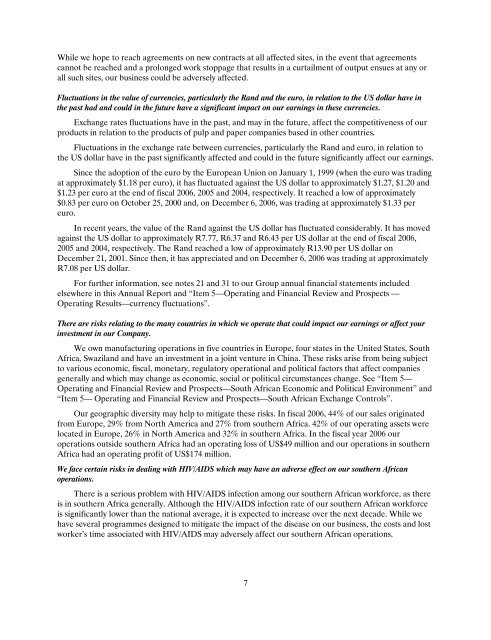You also want an ePaper? Increase the reach of your titles
YUMPU automatically turns print PDFs into web optimized ePapers that Google loves.
While we hope to reach agreements on new contracts at all affected sites, in the event that agreements<br />
cannot be reached and a prolonged work stoppage that results in a curtailment of output ensues at any or<br />
all such sites, our business could be adversely affected.<br />
Fluctuations in the value of currencies, particularly the Rand and the euro, in relation to the US dollar have in<br />
the past had and could in the future have a significant impact on our earnings in these currencies.<br />
Exchange rates fluctuations have in the past, and may in the future, affect the competitiveness of our<br />
products in relation to the products of pulp and paper companies based in other countries.<br />
Fluctuations in the exchange rate between currencies, particularly the Rand and euro, in relation to<br />
the US dollar have in the past significantly affected and could in the future significantly affect our earnings.<br />
Since the adoption of the euro by the European Union on January 1, 1999 (when the euro was trading<br />
at approximately $1.18 per euro), it has fluctuated against the US dollar to approximately $1.27, $1.<strong>20</strong> and<br />
$1.23 per euro at the end of fiscal <strong><strong>20</strong>06</strong>, <strong>20</strong>05 and <strong>20</strong>04, respectively. It reached a low of approximately<br />
$0.83 per euro on October 25, <strong>20</strong>00 and, on December 6, <strong><strong>20</strong>06</strong>, was trading at approximately $1.33 per<br />
euro.<br />
In recent years, the value of the Rand against the US dollar has fluctuated considerably. It has moved<br />
against the US dollar to approximately R7.77, R6.37 and R6.43 per US dollar at the end of fiscal <strong><strong>20</strong>06</strong>,<br />
<strong>20</strong>05 and <strong>20</strong>04, respectively. The Rand reached a low of approximately R13.90 per US dollar on<br />
December 21, <strong>20</strong>01. Since then, it has appreciated and on December 6, <strong><strong>20</strong>06</strong> was trading at approximately<br />
R7.08 per US dollar.<br />
For further information, see notes 21 and 31 to our Group annual financial statements included<br />
elsewhere in this Annual Report and “Item 5—Operating and Financial Review and Prospects —<br />
Operating Results—currency fluctuations”.<br />
There are risks relating to the many countries in which we operate that could impact our earnings or affect your<br />
investment in our Company.<br />
We own manufacturing operations in five countries in Europe, four states in the United States, South<br />
Africa, Swaziland and have an investment in a joint venture in China. These risks arise from being subject<br />
to various economic, fiscal, monetary, regulatory operational and political factors that affect companies<br />
generally and which may change as economic, social or political circumstances change. See “Item 5—<br />
Operating and Financial Review and Prospects—South African Economic and Political Environment” and<br />
“Item 5— Operating and Financial Review and Prospects—South African Exchange Controls”.<br />
Our geographic diversity may help to mitigate these risks. In fiscal <strong><strong>20</strong>06</strong>, 44% of our sales originated<br />
from Europe, 29% from North America and 27% from southern Africa. 42% of our operating assets were<br />
located in Europe, 26% in North America and 32% in southern Africa. In the fiscal year <strong><strong>20</strong>06</strong> our<br />
operations outside southern Africa had an operating loss of US$49 million and our operations in southern<br />
Africa had an operating profit of US$174 million.<br />
We face certain risks in dealing with HIV/AIDS which may have an adverse effect on our southern African<br />
operations.<br />
There is a serious problem with HIV/AIDS infection among our southern African workforce, as there<br />
is in southern Africa generally. Although the HIV/AIDS infection rate of our southern African workforce<br />
is significantly lower than the national average, it is expected to increase over the next decade. While we<br />
have several programmes designed to mitigate the impact of the disease on our business, the costs and lost<br />
worker’s time associated with HIV/AIDS may adversely affect our southern African operations.<br />
7
















